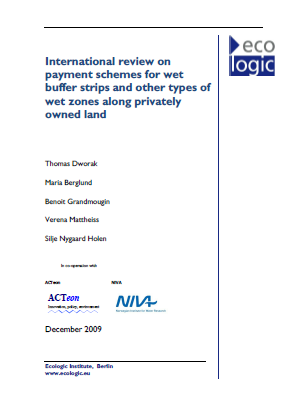International Review on Payment Schemes for Wet Buffer Strips and other Types of Wet Zones along Privately Owned Land
- Publication
- Citation
Dworak T.; Berglund, M.; Grandmougin, B.; Mattheiss, V.; Holen, S.; 2009. International review on payment schemes for wet buffer strips and other types of wet zones along privately owned land. Study for RWS-Waterdienst. Ecologic Institute, Berlin/Wien.
The main focus of the study is to investigate a system of payment "euro-compatible" which could allow remunerating the farmer for the environmental services provided by the wet buffer strip. The study is available for download.
With the scope to support the Dutch Ministry of Traffic, Public Works and Water Management in the establishment of wet buffer strips, the study investigated five agri-environmental payment schemes triggering permanent land use change in 11 European countries. The measures investigated are buffer strips, creation of wetlands, land purchase and preserving and developing nature conservation and water protection areas. In addition, case studies were carried out. In three countries (Germany, France, Sweden) case studies were carried out investigating the details behind the payment schemes as well as other factors influencing farmer's behaviour.



